#eruption of thera
Photo

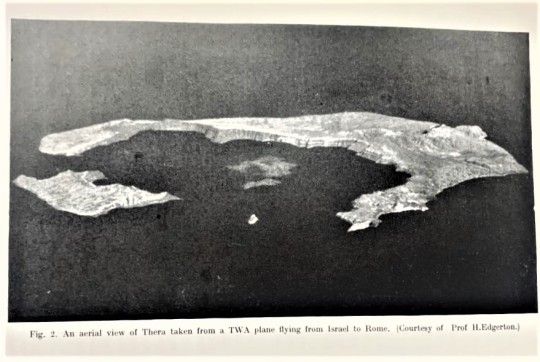


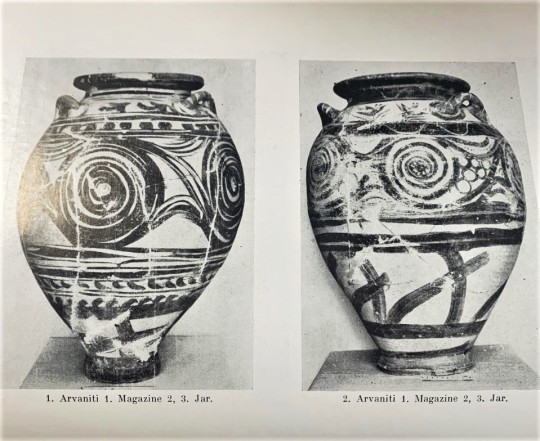
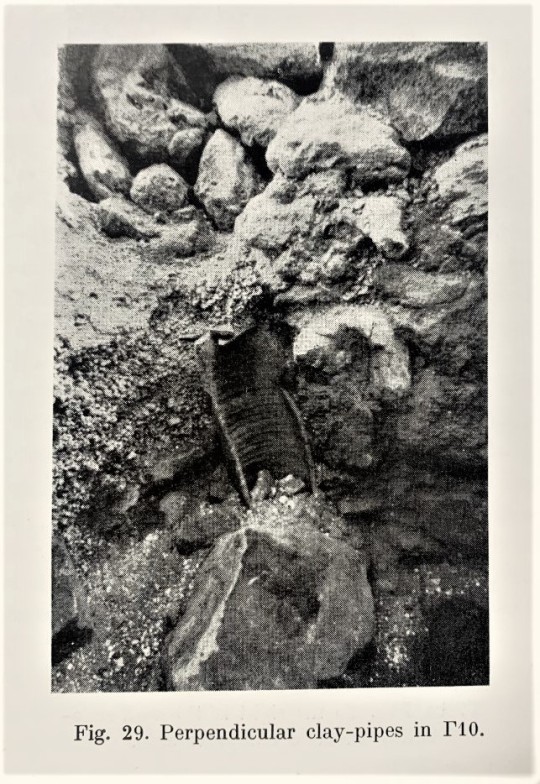


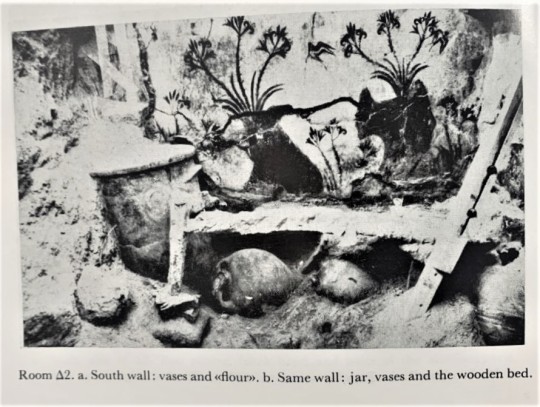

Excavations at Thera
The destruction of Pompeii by the volcano Vesuvius has become synonymous with the nature disaster of volcanic eruptions. The eruption of Vesuvius, among the deadliest in history, was the first natural disaster of its kind to have a first-handwritten account and this documented event has persisted in the public consciousness for nearly two millennia. Yet, despite being the one of the most famous and the deadliest, the eruption of Vesuvius is far from the most destructive. That honor might well go to the eruption of Thera in the 16th or 17th century BCE.
Excavations conducted on this Cycladic Island (among the Aegean Islands), such as the ones recorded in Excavations at Thera a seven-volume set of reports written by by the noted Greek archaeologist Spyridon Marinatos and published by Archaiologikē Hetaireia en Athēnais between 1967-1971, showed that during the Minoan period (2000-1200 BCE) Thera once held an integral port city. Remains showed that though the city was flourishing, its inhabitants abandoned the island for reasons that would soon become apparent to the excavators. It didn’t take long for archaeologists to discover that Thera once held an oval shape, differing greatly to the crescent it is today. Further inspection revealed that several ancient structures were far underwater, pointing to the island collapsing in on itself after their construction. It wasn’t long before the pieces were put together, leading to the discovery that Thera once held an active volcano that erupted in the Minoan period, destroying the island in its entirety.
The collapse of the Minoan civilization has been a mystery that persists to this day, yet finding this once active volcano led many to draw lines of connection between the two events. The reports written by Professor Marinatos reference this theory as near fact when describing the history of the ancient civilization. Such a theory does make a good amount of sense as this eruption would have been much greater than that of Vesuvius with estimated effects reaching all the way to China with reports of a series of harsh winters. Yet as excavations on both the Cycladic Islands and Crete continued, the date for the eruption got pushed back as the fall of the Minoan civilization crept forward. Currently the most accurate date for the eruption of Thera is 1628 BCE with some room for error while the fall of the Minoans sits between 1200-1100 BCE.
View more of my Classics posts.
– LauraJean, Special Collections Undergraduate Classics Intern
#Eruption of Thera#Thera#volcanoes#greek history#Minoan history#Cyclades#volcanic eruptions#Crete#Excavations at Thera#Spyridon Marinatos#archaeology#Greek archaeology#Archaiologikē Hetaireia en Athēnais#Archaeological Society at Athens#Classics#LauraJean
65 notes
·
View notes
Note
Do the Greeks believe Santorini was Atlantis, or only the locals who want tourism?
Am I detecting some scepticism? 😂 Well, Atlantis is a fictional island first devised by Plato. What interests scholars is not whether Atlantis existed but what served as inspiration for it instead.
Plato says Atlantis was beyond the Pillars of Hercules, which nowadays is Gibraltar, but some believe it used to be a different place in Plato’s time, somewhere in the Mediterranean or even close or in Greek territory. In any case, scholars have suggested about two-three historical events potentially serving as inspiration for Atlantis and that of Santorini is the most popular one to date.
In Plato’s work, Atlantis was a very advanced island civilisation which attacked Plato’s concept of an ideal Athens and was thus defeated. It fell greatly out of favour with the gods and the civilisation was utterly destroyed and the island submerged into the ocean.
Santorini, or Thera as is its official name, was home to a very advanced Minoan colony back in 3600 BC, remnants of which you can see today in the archaeological sites of the island. The place was prosperous and flourishing. In 1600 BC, the volcano of Thera erupted. This is confirmed to have been one of the most violent volcanic events in human history. All life on the island was exterminated. The eruption caused enormous tsunamis that hit the island of Crete, causing irreversible destruction to the Minoan civilisation there and gradually leading to its overall extinction. The tsunamis farther hit Egypt, causing so much trouble there that it is said the Biblical Ten Plagues of Egypt were about all the problems caused by the eruption of Thera. (I learned this on Tumblr myself! XD)
Most importantly, Thera itself, which used to be a round island called Strongíli (Στρογγύλη - round), exploded and half the island was submerged into the sea. This is why Santorini now has sort of a half-moon shape.
So, it comes down to whether Santorinians or Greeks in general think Atlantis is a real place. I don’t know about that. However, believing that Plato was inspired by Santorini’s story is not far off, neither is the theory that it is the real version of Atlantis, since historians entertained this possibility first. Santorinians weren’t fooling you, neither were they being weirdos, they just were asserting their wishful confidence that their island was indeed the inspiration for Atlantis.
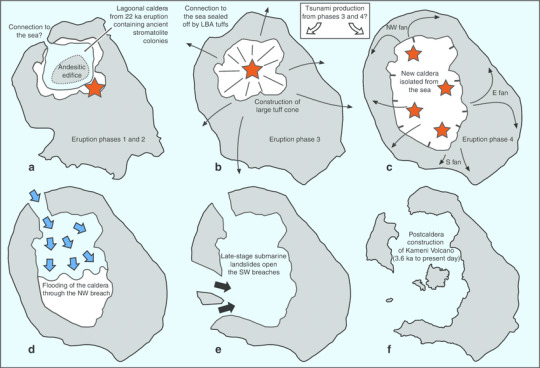
Santorini during and after the eruption. Graph by this article in ResearchGate.
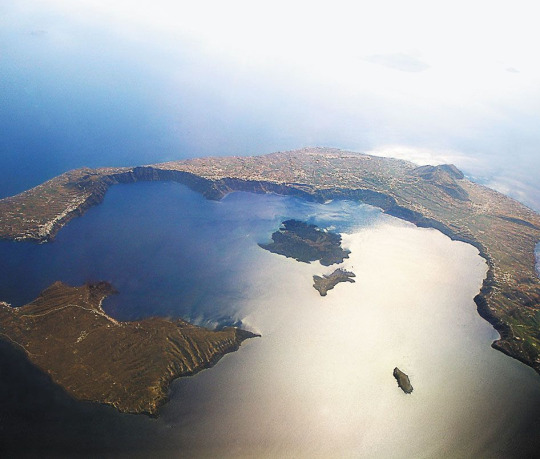
Santorini from above. You can tell all the parts that blew up and took a dive. Fun fact: the central darker small land (Νέα Καμένη - Nea Kameni - New Burnt Land) was birthed by the still very much active volcano progressively since the 16th century and it is the youngest geological formation in the Mediterranean Sea.
#greece#santorini#atlantis#volcano#plato#eruption of thera#history#minoan civilization#minoan history#greek history#cycladic islands#anon#ask#greek islands#greek facts
52 notes
·
View notes
Text
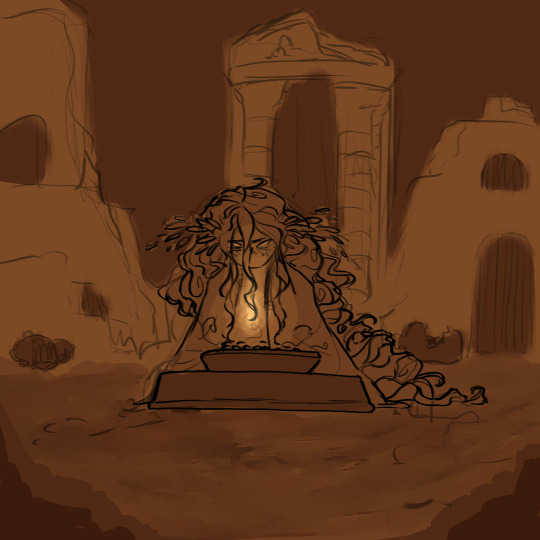
Left this abandoned in the drafts (which is a bit ironic) but it's a spin on this post, where instead of Apollo just being locked in some room on Olympus somewhere, he's bound to the ruins of an abandoned Ancient Greek city. Maybe somewhere near Delphi, maybe Troy, idk.
#trials of apollo#toa apollo#lester papadopoulos#sunny speaks#would this count as another au? idk#apollart#I got this Idea after learning about ancient Thera (which I can't believe I didn't know about before)#It was kind of the Ancient Greek equivalent to Pompeii? Except the volcanic eruption was MUCH more catastrophic#but because the eruption was so big the people on the island had warning signs for like a decade before it happened#So we have ruins that have been perfectly preserved but there are no bodies#Bc all the people were able to evacuate before the disaster#I mean there aren't even animal corpses at these sites they got everyone out#Fun fact this is also considered to be a large reason why Minoan civilization ended up falling apart#ANYWAYS all that aside I heard “abandoned ruins that have been perfectly preserved in ash” and immediately thought “Hmmmm yes ... suffering#Though to be clear I would not put Apollo in the ruins of ancient Thera (Tho the thought of him being the local cryptid of Santorini is fun#But you know what other city was burned to the ground? Heeheehee
258 notes
·
View notes
Text
i would like, in these moments post-ides of march, to take a moment to advocate for one of my favourite series, the chronicles of st. mary's and its offspring the time police. the second is exactly what it says on the tin, the first? the first is about an institute that conducts historical research through time travel in contemporary time. including, in the first time police book, the assassination of julius caesar, featuring such gems as:

-

-

#look they're fucking hilarious#and they even did the eruption of thera and i wasn't mad at it!#jodi taylor is a gift#ides of march
7 notes
·
View notes
Text
Time Travel Question 10: Ancient History III
These Questions are the result of suggestions from the previous iteration. I'm combining some similar ones, so some are going to be a little vague. I'm going to also split into a whole lot of different polls because there were so many good and creative ideas. (Seriously, I love the people of Tumblr).
Please add new suggestions for this category below if you have them for future consideration.
You are welcome to suggest specific things from the Library of Alexandria. There will be polls for that.
#Time Travel#The Acropolis#The Library of Alexandria#Eleusinian Mysteries#Indigenous History#Bacchus#Great Zimbabwe#Ancient Egypt#Akrotiri#Thera#Minoan#Jewish History#The First Temple#Picantes#Etruscans#Dacians
390 notes
·
View notes
Photo
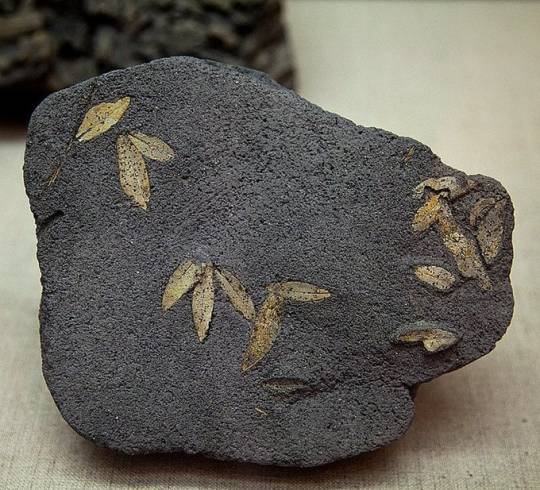
Fossilized Olive Leaves Found on Santorini, Greece
Fossilized olive leaves from a tree that was alive 60,000 years ago on the island of Thira (the modern Santorini) are immortalized in the volcanic ash that encased them after an eruption.
The exquisite fossils were discovered at an old pumice quarry on the outskirts of Thira, a town on Santorini; in addition, three new plant fossil sites were also located in abandoned quarries nearby on the island, which was almost completely destroyed in a later eruption that occurred in the year 1650 BC.
Blowing apart the island that at that time was called Thira by its Minoan inhabitants, all that was left was a rim of land encircling a caldera; now known as Santorini, the crescent-shaped island marks one of the most cataclysmic eruptions that has ever taken place within recorded history.
The fossilized olive leaves are now exhibited at the Museum of Prehistoric Thera in the capital Fira on Santorini.
#Fossilized Olive Leaves Found on Santorini Greece#Cyclades islands#fossil#ancient artifacts#archeology#archeolgst#paleontology#history#history news#ancient history#ancient culture#ancient civilizations#greek history
290 notes
·
View notes
Text
In light of another week break from One Piece, I'd like to share an observation I made about the Great Kingdom that was before I even knew about the Atlantis theories lol
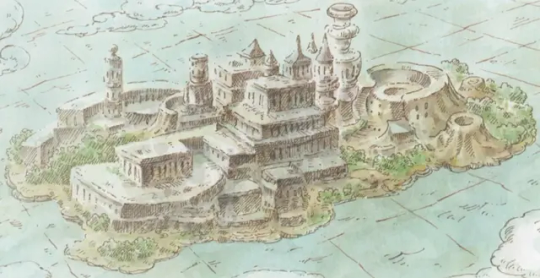
Above is an image that was shown both in the manga and anime while Professor Clover was talking about the Great Kingdom to the Five Elders. I was looking at this image after chp 1113 came out and the buildings at the front reminded me of something:

This is an artistic rendition of the palace of Knossos on the island of Crete. It was built by the Minoan civilization (contemporaries of Ancient Egyptians, the site was abandoned over 600 years before the golden age of Ancient Greece) and they were named after King Minos from Greek Mythology (the guy with the labyrinth and the minotaur) since it was believed he ruled at this palace. We don't actually know what they called themselves, among other things, since their writing system hasn't been cracked yet.
We do know that there were Minoan settlements on the island of Thera just north of Crete, you probably know it as Santorini
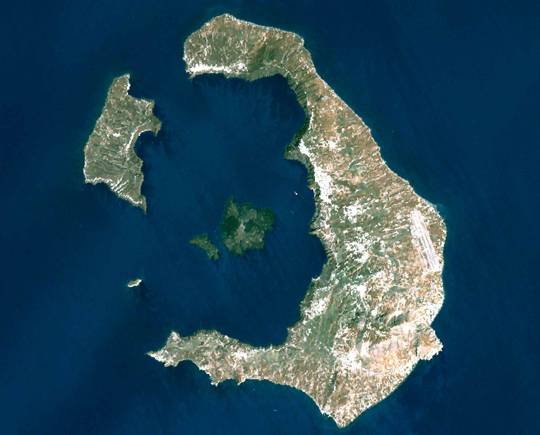
The island didn't always look like this though. All those small islands were once part of one larger island, and it looks how it does today because of a massive volcanic event during Minoan times known as the Thera Eruption. It's given a Whole Name because it's one of the largest volcanic events in human history. Like,,, there's records from all the way in China describing a volcanic winter around the time of this eruption. The entire north side of Santorini's bay? that's a whole fucking caldera. When the eruption happened, it completely reshaped the island and sunk a large chunk of land with it. Crete itself was hit by massive earthquakes and tsunamis because of it (the islands are only about 140km/90mi apart, the waves are speculated to have been up to 12m high, that's as tall as a small giant in One Piece!).
The kicker here is that there's theories about this event inspiring stories of Atlantis. All of this might be a stretch but I'm also not putting it passed Oda Lover of World Histories and Cultures Eiichiro to be drawing from Knossos when designing that image of the Great Kingdom. Whether or not that's what the kingdom actually looks like doesn't really matter. It could be just an early design since it was made all the way back in chp 395. What it would mean is that Oda was doing a shit ton of research in his early development of the Great Kingdom.
Tl;dr: the image of the Great Kingdom from chp 395 looks strikingly similar to the Knossos Palace in Crete, which is associated with a significant volcanic eruption that possibly inspired stories of Atlantis. There's also connecting themes of a writing system lost to history and a major phenomenon that caused sinking land, earthquakes, and tsunamis.
#i can't believe i'm using my bachelors degree for one piece#the insanity continues!!!#one piece#one piece spoilers#egghead spoilers#op spoilers#one piece 1113#one piece 1114
13 notes
·
View notes
Text
Flag of the Minoan Empire

This is the flag of the Minoan Empire. It comes from a world where the eruption of Thera never happened. As a result the Minoan civilization continued to flourish and eventually went on to conquer the Mycenaeans. The Minoans forged several trade networks and founded an empire that stretched across the Mediterranean. The Minoan conquest of the Mycenaeans meant that Ancient Greek civilization, as we know it, never came to be.
The Minoan Empire prospered for many centuries, but just as Greece and Rome did in our world, eventually it had to come to an end. However, just as later civilizations looked to Greece and Rome for influence and inspiration, so to did the future civilizations of this world look to the Minoans. Minoan culture cast a heavy shadow on future civilizations, and the legacy of the art and ideas would live on even after thousands of years.
The dark purple represents the wine-dark sea, and the Minoans control over it. The golden axes are Labrys, a type of double bladed axe commonly found in Minoan artwork and ruins. They are believed to have symbolized authority.
Link to the original flag on my blog: https://drakoniandgriffalco.blogspot.com/2016/02/flag-of-minoan-empire.html?m=1
#alternate history#flag#flags#alternate history flag#alternate history flags#vexillology#ancient greeks#ancient greece#greece#crete#minoan#minoans#Minoan Empire#Mycenaean#mycena#Mycenaeans#alt history
28 notes
·
View notes
Note
Hey, I’m sorry but I really need clarification on your latest post. When you talk about people who believe Atlantis was real, do you mean people who talk about the possibility that Plato’s story was influenced by the cultural memory of the Minoans and the eruption on Thera/Santorini and as such has some “real” elements or are there people who really think a place called Atlantis existed? Because I hear the first one a lot from my teacher at school and he doesn’t seem the type to hold dangerous beliefs like what you described. Sorry if it was obvious, my reading comprehension is sometimes really bad.
Yeah, that's a different class of belief, since it still holds that Atlantis is fundamentally fictional or at least legendary. I'm talking about the kind of people who think that Atlantis was literally real, in the same way young earth creationists believe the world was literally created in six days.
9 notes
·
View notes
Text
The eruption of the volcano on the island of Thera was likely one of the inspirations for the legend of Atlantis.
Thera was inhabited by a Minoan colony, and the Minoan culture on Crete was very negatively impacted by the eruption of Thera.
Numenor is posited in Tolkien's writings as Atlantis.
Conclusion: Please draw Numenoreans in Minoan fashions!!
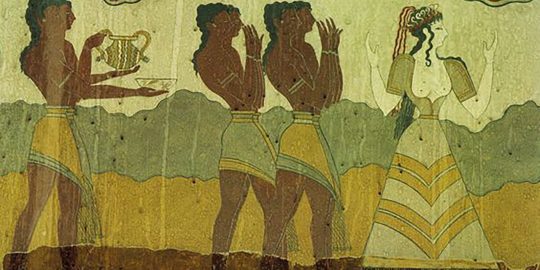

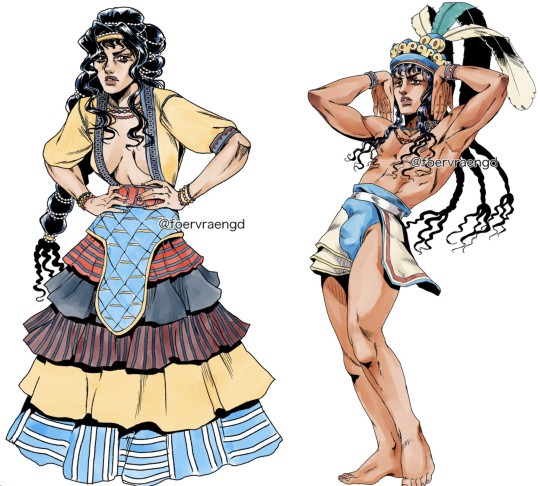
8 notes
·
View notes
Text
Most people have heard about the devastating destruction of Pompeii by the eruption of Mount Vesuvius in A.D. 79. But did you know about the equally disastrous obliteration of the ancient city of Akrotiri in Greece? The events that led to its destruction were only discovered when the city emerged from the rubble in 1967.
40 notes
·
View notes
Text
DWC February 2024
Day 4: Vengeance / Satisfaction
“I am glad you could come, magister.”
A tip had led Luminash here, a request from Dragonscale researchers exploring the Dream to examine a suspected Titan device they had said matched the Arcane energies detected from the heart of the Dream, which sadly Fyrakk had left inaccessible – for now.
An elaborate lie, it seemed now, as he looked into his own reflection, or something resembling it.
His hair was golden, skin fair, eyes the blue-white of the Arcane, clothed in blues and golds. He had not yet seen this other self in the flesh, only through glimpses between timeways, but everything about him was a corruption.
The other’s hair’s sheen had dulled, skin fair, yes, but his arms were blackened and cracked – it called to mind a cooling lava flow – and his eyes bore the orange of flame, and something else, in their depths, a flicker of purple-black.
Luminash breathed deeply, in and out, a steady rhythm. It could not keep the twisting knot in his stomach entirely at bay, although it certainly did help. He had wondered, since the cryptic warning in Thaldrazsus, if this other would make good on his threat, and so it seemed he had.
“So I have,” Luminash replied, breaking what had felt an eternity of silence, “But why have you?”
The other did not move. The way his eyes flicked from side to side, the way he stayed so rigid, something was wrong, Luminash was certain. What, though, he could not say.
“Theras.”
Luminash exhaled sharply. He knew, of course, before the name had been uttered. He had seen the loss his other self had endured, the guilt and fear and desperation.
“If I could bear to wear a glove, magister, I would throw it down. I will have satisfaction. I will…” He stopped, a pause as if choking back tears – or choking on fear, “I will have my family back.”
Then, the serene green of the Dream erupted around them in flame.
@daily-writing-challenge
6 notes
·
View notes
Note
Re: Atlantis, what I think happened is that Plato kept on changing the details until it came across as something out of an Oz book because the statement "The eruption of Thera caused the end of the Cretan empire" was extremely offensive to his fellow Athenians, who probably held the efforts of Theseus and Ariadne had ended the Cretan Empire as a matter of patriotic pride. But anyway, is that the reason it gets more tourism than Thebes or Argos or Sparta or Mycenae or Ithaca?
No it’s because it’s prettier
7 notes
·
View notes
Text
Atlantis and It's Evolution
J.R.R. Tolkien feigned to uncover lost documents when he wove various ancient myths into the lore of Middle Earth. This is a technique originated by Plato in constructing Atlantis. Plato claimed he found a source in Egyptian recounting the stories of Atlantis. His “translation” into Greek is the justification for several phonetically Greek names.
Although Atlantis was not the most significant element in Plato’s dialogues, it has inspired the imagination of successive generations and become a cornerstone of fantastical storytelling. Nor was it the only fantasy tale in Antiquity, as Lucian of Samosata wrote A True Story in the Second century A.D. to mock the genre of fantasy as a travelog. Tales beyond the edge of the map of the known world were quite popular in Antiquity. Of them all though, Atlantis is the only one still widely known by almost everyone in the World and certainly by every adult in the Western World.
In 360 B.C., Plato penned the story of ancient Athens defeating Atlantis. Plato was discoursing upon the ideal civil state in two dialogues, Critias and Timaeus, written as sequels to The Republic. In his dialogues, he discusses two different states. One is the wealthy and luxuriously decadent world power of Atlantis, while the other is the almost spartan ancient Athens. Plato’s ideal Republic is a system in which men and women are both educated and equal, but only within their state-assigned class, and only the warrior class rules. Personally, I believe that this system is remarkably similar to Aldous Huxley’s Brave New World.
These two Platonic dialogues both reference Timaeus’ ancestor, Solon as the wisest of the seven sages and lawgiver of Athens who visited Egypt, where he heard the tale from several Egyptians. Salon told Dropides who told his great-grandson Timaeus, from which Plato found the tale. It is a tale of a great island, just past the Pillars of Heracles (the modern-day Strait of Gibraltar) in the Atlantic Ocean. The Kings of Atlantis descended from Poseidon and Cleito. Atlantis was the source of the metal Oreichalkos, which is only a bit less valuable than gold. Although Plato places Atlantis 9,000 years into his past, he inserts Athens into the tale as an ally until Atlantis becomes corrupt and imperialistic in its decadence. Morally superior Athens defeats Atlantis in war, freeing the entire conquered world. Then Atlantis is sunk beneath the waves with earthquakes and tsunamis as divine retribution for their corruption.
The dialogues are an allegory designed to caution the people of Athens from becoming too decadent or imperialistic. Plato warns against the decay of morality in favor of decadence, and imperialism, and he cautions against transgressing divine morality. This caution against doing folly may have been influenced by Plato’s experience of the Peloponnesian Wars and by the events and choices made by Athens leading up to the Wars. His cause was performed for the Panathenaea Games in honor of Athena and may be seen as state propaganda.
Plato’s claim to the historicity of Atlantis is belied by his dating of Athens as an ancient contemporary, making it over 9,000 years old in Plato’s time, older than ancient Egypt, and requiring a reminder of its past by Egyptians. This is about as realistic as Tolkien’s feign.
Still, people are inspired to look for a grain of true history within Plato’s account. Some point to the destruction of Knossos and the Minoans from the eruption of the Thera (modern Santorini) super-volcano in the 1,600s B.C. Others say the “sea people” accused of precipitating the Bronze Age Collapse around 1,200 B.C. may be the source of imperialism or refugees. Others note the Wars between the Greeks and Persians in which Athens defeated the much larger Persian navy and established itself as the region’s naval power may have been an inspiration.
Perhaps some of these accounts are accurate inspirations, but they do not suggest Atlantis existed. In the 1880s, Ignatius Donnelly authored Atlantis and the Antediluvian World. He argued that Atlantis was not a myth, but the birthplace of humanity’s first civilization prior to Noah and the home of the Nephilim and their giant offspring. He argued that ancient peoples of Europe and America worshiped the Atlantean kings who colonized Egypt, Mesoamerica, and Western Europe, from which we derive Aryans.
Within the context of the 1880s, the remains of the city of Troy, long believed to be a Homeric myth, had just been discovered. Other archeological sites were slowly being explored, including Knossos and Mykene. Most people still believed the Biblical flood as literal, with all cultures having an apocryphal flood story, Plato’s timeline placed Atlantis well before Noah.
Donnelly’s theories were adopted as state propaganda by the Nazis. The Nazis argued they are the living descendants of the true Aryans who survived the fall of Atlantis. They argue the Atlanteans were superhumans who fell not from divine judgment of their corruption but by intermixing with “lesser races”. Only by purifying Aryan blood, and removing corrupt lesser races, could the superhuman be restored to rightly rule the world.
In more modern times, people still search for Atlantis, saying Plato had some details of time or place wrong. Without any real evidence, people have placed Atlantis in the Canary Islands, the Guelb er Richat (Eye of the Sahara), Minoa, and Bulgaria or the Black Sea, amongst other possibilities. They repeatedly source Egar Cayce, a supposed psychic. He supposedly had thousands of genuine readings. He claimed the Atlanteans had been reincarnated as the American people from the United States.
“Be it true that there is the fact of reincarnation, and that souls that once occupied such an environ [i.e. Atlantis] are entering the earth's sphere and inhabiting individuals in the present, is it any wonder that—if they made such alterations in the affairs of the earth in their day, as to bring destruction upon themselves—if they are entering now, they might make many changes in the affairs of peoples and individuals in the present?"
(pg 50 Edgar Cayce on Atlantis by Edgar Evans)
"In Yucatan there is the EMBLEM of same. Let’s clarify this, for it may the more easily be found. For they will be brought to this America, these United States. A portion is to be carried, as we find, to the Pennsylvania State Museum. A portion is to be carried to the Washington preservations of such findings; or to Chicago."
(page 89 Edgar Cayce on Atlantis by Edgar Evans)
In the Discovery series Hunting Atlantis, author Stel Pavlou and volcanologist Jess Phoenix, who has a Bachelor’s in history and a Master’s in geology, say Atlantis existed in 4,900 B.C. They say Plato “based his timeline on ancient Egyptian Kings’ Lists” for his date of the 9,000s B.C. and it was in Bulgaria on the Black Sea. However, Plato did not have access to these King Lists and any version accessible today is known to have been altered.
In the National Geographic series Drain the Oceans, the show slowly showcases four underwater environments. All except the third are merely natural environments that are played up for drama, admits the series. However, the third environment, an ancient town named Pavlopetri, is a genuine Bronze Age town that had sunk below the sea due to the rise in sea levels and other natural disasters. It seems as if the idea of Atlantis was used simply to garner views instead of something genuinely investigated.
Most people are content to enjoy Atlantis as little more than an interesting setting for adventure stories. J.R.R. Tolkien had Numenor as a fictional island setting in the first two ages of Middle Earth. It was the first great kingdom of men, but it was corrupted by the fallen angel Sauron into attacking Valinor, the undying land of the elves and angels. As punishment, the Creator destroyed Numenor by an Earthquake and tsunami in the second age of Middle Earth, a few thousand years before the Lord of the Rings where Sauron was finally defeated. This is Tolkien’s Atlantis.
Disney adapted the idea in Atlantis: The Lost World and the sequel, Atlantis: Milo’s Return. Disney’s original movies have Atlantis still existing in a giant cave under the ocean with its air pocket, and the Atlanteans being trapped primitives aware of the outside world. Disney’s sequel took inspiration from Donnally’s book. The characters leave Atlantis to travel to the surface world for further adventures in Norway and Mexico and in other nondescript places before returning to Atlantis and then bringing it back to the surface.
The video game Assassin’s Creed Odyssey has downloadable content titled Atlantis DLC, allowing for a story with some time exploring Atlantis, almost as a set-aside. The first two chapters are set within the Underworld. The content involving Atlantis only begins in the third chapter. Atlantis was merely set dressing for the story. While the setting is as Plato described, the characterization is less true to Plato. The in-game Poseidon admits to routinely sending great deluges when the Atlanteans prove themselves to not be worthy of mercy.
Others believe that Atlantis was a historical civilization that existed 11,000 years ago. It’s simply that such knowledge has either been purposefully hidden or lost.
In Secret Origins, the author relays his ideas of how Atlantis actually existed and how such knowledge might have been kept secret. He “quotes” Plato, Edgar Cayce, Ishmael Perez, Helena Blavatsky, and Matthias De Stefano, all without citation. The author merely expects his viewers to believe his claims. It was certainly an interesting and educational set of videos.
Atlantis seems to have become a lost city-state starting around the late 19th until today with figures such as Ignatius Donally and Edgar Cayce. Up until then, the city was considered nothing more than a fable and parable created by Plato to flatter Athens and warn of the folly of men.

Acknowledgments:
Louis D’Angelo
He played Assassin’s Creed Odyssey's Atlantis DLC
2 notes
·
View notes
Text

A Marine Style pot, characteristic of the Late Minoan IB ceramic period that followed the eruption of Thera
3 notes
·
View notes
Text
Time Travel Question 37: Ancient History XVII and Earlier
These Questions are the result of suggestions from the previous iteration.
This category may include suggestions made too late to fall into the correct earlier time grouping. Basically, I'd already moved on to human history, but I'd periodically get a pre-homin suggestion, hence the occasional random item waaay out of it's time period, rather than reopen the category.
In some cases a culture lasted a really long time and I grouped them by whether it was likely the later or earlier grouping made the most sense with the information I had. (Invention ofs tend to fall in an earlier grouping if it's still open. Ones that imply height of or just before something tend to get grouped later, but not always. Sometimes I'll split two different things from the same culture into different polls because they involve separate research goals or the like).
Please add new suggestions below if you have them for future consideration. All cultures and time periods welcome.
#Time Travel#Ancient History#Thera#Crete#Tekhelet#Jewish History#Fashion History#Troy#Western Asia#Ancient Greece#Greek Mythology#Gilgamesh#Sumer#Western Asian History#Pilipili#Trans History#Queer History#History of Religion#Venus of Willendorf#Neolithic#Early Humans#Chinese History#Wu Zeitan#Friesenhahn Cave#Homotheriums#Mammoths#Hominins#Dionysius#Greek Religion
105 notes
·
View notes